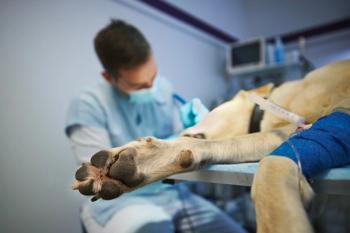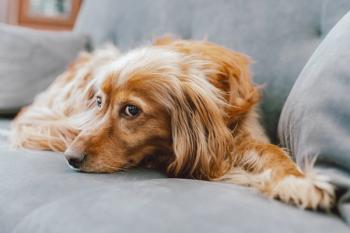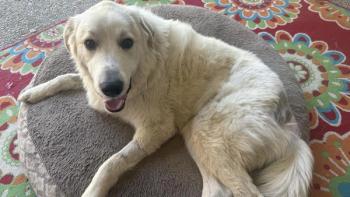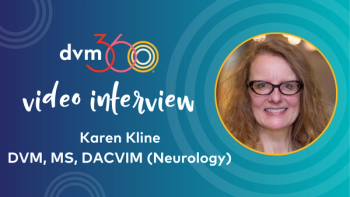
The neurologic exam (Proceedings)
The neurologic exam is the most important diagnostic test in the evaluation of neurologic disease.
The neurologic exam is the most important diagnostic test in the evaluation of neurologic disease.
A routine should be used for every exam, just as for a physical examination
• Easier to perform a complete exam if you have a pattern, especially in non typical scenarios (e.g. spinal cord trauma, painful or fractious animals)
• Easier to remember all of the components when documenting exam and interpreting findings
Many parts of the exam can be subjective – knowing the expected response of each test in a normal patient makes abnormalities more apparent
• Examine neurologically normal patients!
Goals of NE
Is patient neurologically normal?
If yes, where is the neuroanatomic localization of abnormality?
• Brain – cerebrum, brainstem, cerebellar
• Spinal cord – C1-5, C6-T2, T3-L3, L4-caudal
• Neuromuscular – neuropathy, junctionopathy, myopathy
• >1 localization? – multifocal/diffuse disease
Differential diagnoses
• DAMNIT V
o Degenerative
o Anomalous/congenital
o Metabolic
o Neoplastic, nutritional
o Infectious, inflammatory, idiopathic, iatrogenic
o Traumatic, toxic
o Vascular
Diagnostic plan formulated from list of likely causes
• Signalment and history are as important as physical and neurologic examinations in ranking potential causes of signs
An accurate exam is essential in working towards these goals
Components of NE
6 basic categories
• Mentation
• Gait/Posture
• Cranial Nerves
• Spinal Reflexes
• Postural Reactions
• Palpation
Initial observations are valuable
Pay attention to the patient while taking your history
Mentation
• Alert (bright, quiet)
• Obtunded (mild, moderate, severe)
• Stuporous
• Comatose
• Additional description as needed – e.g. compulsive, aggressive, hyper-excitable
Gait/Posture
• Posture, body position at rest
o Head tilt or turn, leaning, involuntary movements, wide based stance
• Gait evaluation
o Ambulatory or non ambulatory
o Ataxia, paresis, plegia, lameness
• If plegic, are superficial and deep pain perception present?
o Other abnormalities associated with movement – e.g. intention tremors, circling, dysmetria
Cranial Nerves
• CN I (Olfactory)
o Sensory path for sense of smell
o Assessed via behavioral response to odors
o Not often performed clinically
• CN II (Optic)
o Sensory path for vision and PLR reflexes
o Assessed via
• Behavioral indications of vision
• Menace response (together with CN VII)
• PLR reflexes (together with CN III)
• Visual placing reactions
• CN III (Oculomotor)
o Parasympathetic motor fibers for pupil constriction
o Innervation of extra ocular muscles (dorsal, medial & ventral recti and ventral oblique)
o Innervation of levator palpebrae muscle
o Assessed via
• Pupil size, PLR reflexes
• Ocular movements (voluntary, physiologic nystagmus)
• Eye position and palpebral fissure size
• CN IV (Trochlear)
o Innervation of dorsal oblique muscle
o Assessed via observation of pupil (cat) or fundoscopic exam (dog)
• CN V (Trigeminal)
o Innervation to muscle of mastication
o Sensory pathway to the face (ophthalmic, maxillary and mandibular branches)
o Assessed via
• Jaw tone, masticatory muscle mass
• Behavioral or reflex response to stimulation
-Palpebral reflex (together with CN VII)
-Corneal reflex (together with CN VI VII)
-Trigeminofacial reflex (together with CN VII)
-Nasal mucosal stimulation
-Cutaneous stimulation at lateral maxilla, mandible
• CN VI (Abducens)
o Innervation of lateral rectus and retractor bulbi muscles
o Assessed via
• Corneal reflex (together with CN V VII)
-Ocular movements (voluntary, physiologic nystagmus)
• Presence of medial strabismus
• CN VII (Facial)
o Innervation to muscles of facial expression
o Sensory path for palate, rostral 2/3 of tongue (taste), inner pinna
o Innervation to lacrimal and majority of salivary glands
o Assessed via
• Menace response (together with CN II)
• Palpebral, corneal reflexes (together with CN V)
• Trigeminofacial reflex (together with CN V)
• Assessment of facial symmetry and movements
• Cutaneous stimulation of inner pinna
• Evaluation of tear production (i.e. Schirmer tear test)
• Response to application of bitter substance to tongue
• CN VIII (Vestibulocochlear)
o Sensory path for hearing
o Sensory path for vestibular input
o Assessed via
• Behavioral responses to sound
• Physiologic nystagmus (together with CN III, IV, VI)
• Presence of signs of vestibular disease (e.g. strabismus, spontaneous nystagmus, head tilt, lean, etc)
• CN IX (Glossopharyngeal)
o Innervation of muscles of pharynx
o Innervation to zygomatic and parotid salivary glands
o Sensory path for caudal 1/3 of the tongue
o Generally considered together with CN X
o Assessed via
• Gag reflex
• Presence of dysphagia
• CN X (Vagus)
o Innervation of pharynx, larynx and palate
o Parasympathetic innervation of viscera
o Sensory path for caudal pharynx, larynx, viscera
o Assessed via
• Gag reflex
• Presence of dysphagia, stridor, regurgitation, altered vocalization
• CN XI (Accessory)
o Innervation of a portion of the cervical musculature
o Assessed via palpation, symmetry of cervical musculature
o Deficits rarely appreciated in isolation of other problems
• CN XII (Hypoglossal)
o Innervation of muscles of the tongue
o Assessed via
• Evaluation of tongue shape, size, symmetry and movements
• Impairment of prehension, mastication, drinking
Spinal Reflexes
• Myotatic Reflexes – monosynaptic, 2 neuron pathway
o Patellar Reflex – L4-6 spinal cord segments (via femoral nerve)
o Gastronemius Reflex – L7-S1 (sciatic nerve)
o Biceps Reflex – C6-8 (musculocutaneous nerve)
o Triceps Reflex – C7-T1 (radial nerve)
• Withdrawal Reflexes – more complex than myotatic reflexes
o Pelvic limb – sciatic and femoral nerves and associated segments
o Thoracic limb – multiple nerves involved
o Not an indication of pain perception
• Perineal Reflex – S1-3 (pudendal nerve)
• Panniculus Reflex – sensory nerves from skin enter spinal cord and synapse bilaterally at C8-T1, motor impulses via lateral thoracic nerves
Postural Reactions
• With weight support – e.g. proprioceptive positioning, visual and tactile placing
• Movement associated – e.g. hopping, wheelbarrowing, extensor postural thrust
Palpation
• Is patient painful? Where? Severity?
• Range of cervical motion – voluntary, directed
• Muscle size and tone
• Bladder size, tone
• Nail wear
Other parts of the physical examination to consider
• Orthopedic exam
• Rectal exam
• Fundic exam
• Cardiovascular exam
Feline NE
• Often limited period of cooperation
• Gait evaluation, postural reactions can be more challenging
• Menace response can be more subtle
• Tendon reflexes may be easier to appreciate
• Panniculus reflex less reliably obtained
• Mass reflex can be dramatic with severe myelopathy
Suggested reading:
Handbook of Veterinary Neurology, 4th Ed, Michael D. Lorenz, Joe N Kornegay, Saunders, 2004
Newsletter
From exam room tips to practice management insights, get trusted veterinary news delivered straight to your inbox—subscribe to dvm360.






